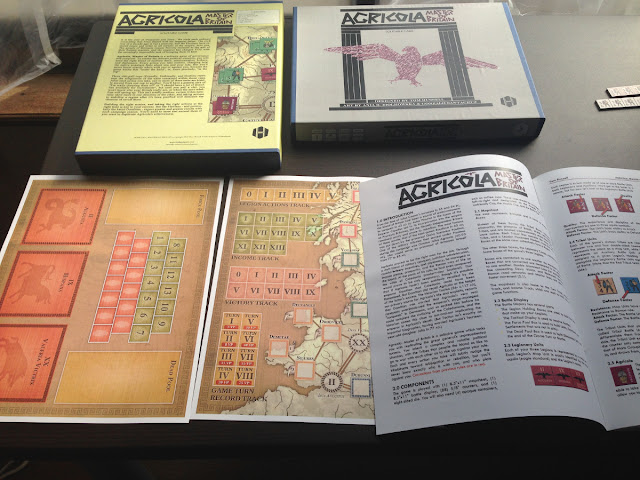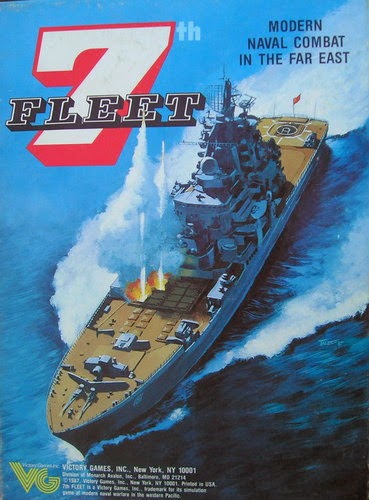At a Glance: Agricola
Agricola lets the player take on the role of the famed Roman general and governor of Brittania in the first century AD. You're faced with the tough job of making friends and outwitting your enemies. The problem is that you're never quite sure who is in which camp until certain points in the game. Sometimes you think you're making all the right moves and you end up with a knife planted firmly in your back. In addition to your own decisions, the game uses a really neat chit-pull mechanic to help determine how things play out.
Add to all this is the fact that you're under pressure from Rome to achieve great things while you're up in Brittania. The empire is crumbling fast and Rome is desperately trying to buttress their defenses by getting as much as they can from their far-flung territories. If you don't perform well, expect to be replaced rather quickly.
Let's take a look at this bad boy:
 |
| Game Box - Front |
You get a pretty sturdy box with a nice cover. Lots of information on the side of the box. This thing is for 1 player, duration of 90 minutes, high solitaire suitability, and medium weight. Hey, what's this? The art is by Ania Ziolkowska and Gonzalo Santacruz! They add a nice layer of cool to this thing.
 |
| Inside the box... |
The rulebook is 12 pages and has nice bold font throughout. It's full color with corrections from the previous ruleset in red. The final page is a Player's Aid.
There is a full-color map sheet of Britain, neatly organized with game turn, VP, and legion actions tracks. The other full-color sheet is used to track Force Pool, Dead Pool and Legion holding boxes.
There is one countersheet in here with 88 counters. These are nice thick quality counters. Two rows of the counters had fallen out of their sheet during transit to Japan and they were in perfect condition when I opened the box.
 |
| A few of the counters from Agricola |
The game counters are clear and colorful with essential information (attack, defense ratings, etc.) easy to read at a glance. I am very happy to report that the colors are very distinct, which is a welcome relief as a color-blind person who has been struggling mightily with Central America's terrain color system for the last two weeks.
Finally, you have an eight-sided die included in the game, used to resolve combat. Its probably because of my D&D roots that I love games that use unconventional die.
So how does this thing play?
There are four cups from which you pull chits in Agricola. Three cups represents friendly, unfriendly, and hostile tribes. The fourth one is a battle cup.
With each turn, you take Legion Actions. This might mean moving legions to a tribal box, suppressing dissent, garrisoning units, peacekeeping, battle, or passing the turn. You can also use your leaders to help reorganize a legion or negotiate with tribal units. Depending on what you do, this influences the movement of chits among the various cups. For example, you might need to move two friendly chits to the unfriendly cup. In this fashion, you know you're likely making someone unhappy but you're not exactly sure who and how much. You won't know until the next phase.
After each legion action, hostile tribes react to what you have done. You pull chits from the hostile cup and match them to their tribal box. Depending on what's in that tribe's box, the unit could be eliminated outright or you might end up with a dead garrison. Tribal leaders could be drawn from the cup, resulting in a warming of relations (to just "unfriendly" instead of hostile). Your legions might get ambushed or face set-piece battles. You might also have tribes going to war with each other. What a headache!
After each legion action, hostile tribes react to what you have done. You pull chits from the hostile cup and match them to their tribal box. Depending on what's in that tribe's box, the unit could be eliminated outright or you might end up with a dead garrison. Tribal leaders could be drawn from the cup, resulting in a warming of relations (to just "unfriendly" instead of hostile). Your legions might get ambushed or face set-piece battles. You might also have tribes going to war with each other. What a headache!
Battle is resolved very quickly with a Deployment phase then an Attack and Defense Round. This goes on until one side is eliminated. Attack and Defense are resolved by rolling the die and adding the result to your unit's attack or defense factor (depending on what you are doing). If it's greater than the enemy's relevant factor, you eliminate the enemy unit.
You can then promote and reorganize your units. The number of chits in the cups is adjusted (you move chits from cup to cup blindly) according to how your legions and auxillaries fared in the battle.
There is a housekeeping phase that allows the enemy to raid your settlements and steal from your treasury. Tribes can be paid off with public works to play nice. You get new soldiers and auxillaries. And then you check your VPs. Each turn has a VP threshold that you must meet. In addition to other triggers, one of the things I like here is that if you don't make a certain number of VPs per turn, the game ends in defeat.
To win the game, you collect VPs by enhancing settlements, having regions without tribal units, having an empty hostile chit cup, and generally bringing peace and prosperity to Brittania.
Agricola looks fun and interesting with some cool mechanics. I especially like the fog of war aspect of the game. You have a general impression of how things are going over with the tribes but you're always on your toes. What's more, you never really know when you're going to face an all-out rebellion. The Battle of Mons Groupius, once triggered, brings all thirteen enemy battle units on to the board for a big showdown with your legions. If you win, it eliminates a big chunk of hostile tribal units and you can rest easy for a turn or two. If you lose, the game is over. Lots of tension and high stakes in this game. Definitely worth checking out!





Comments
Post a Comment